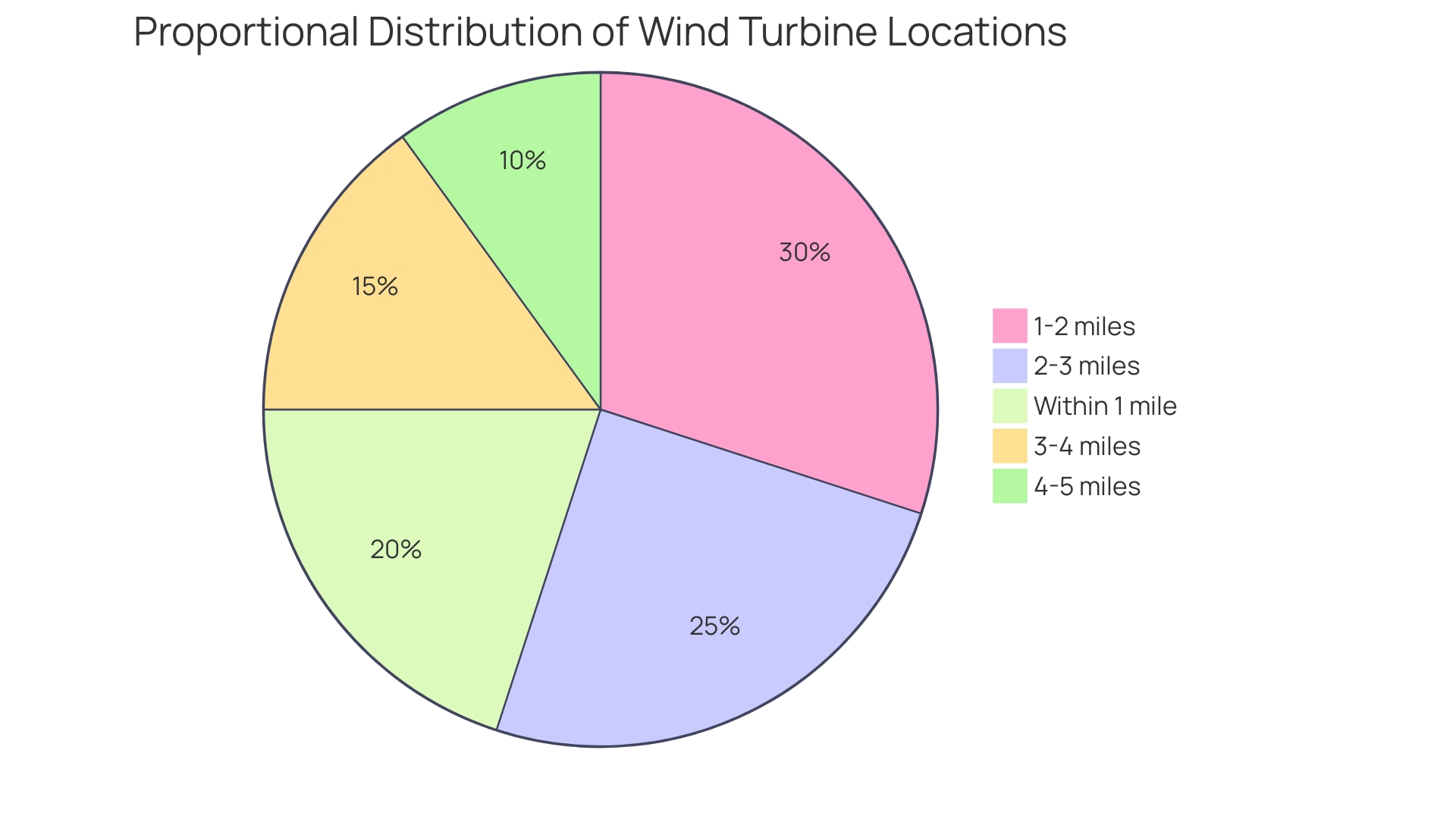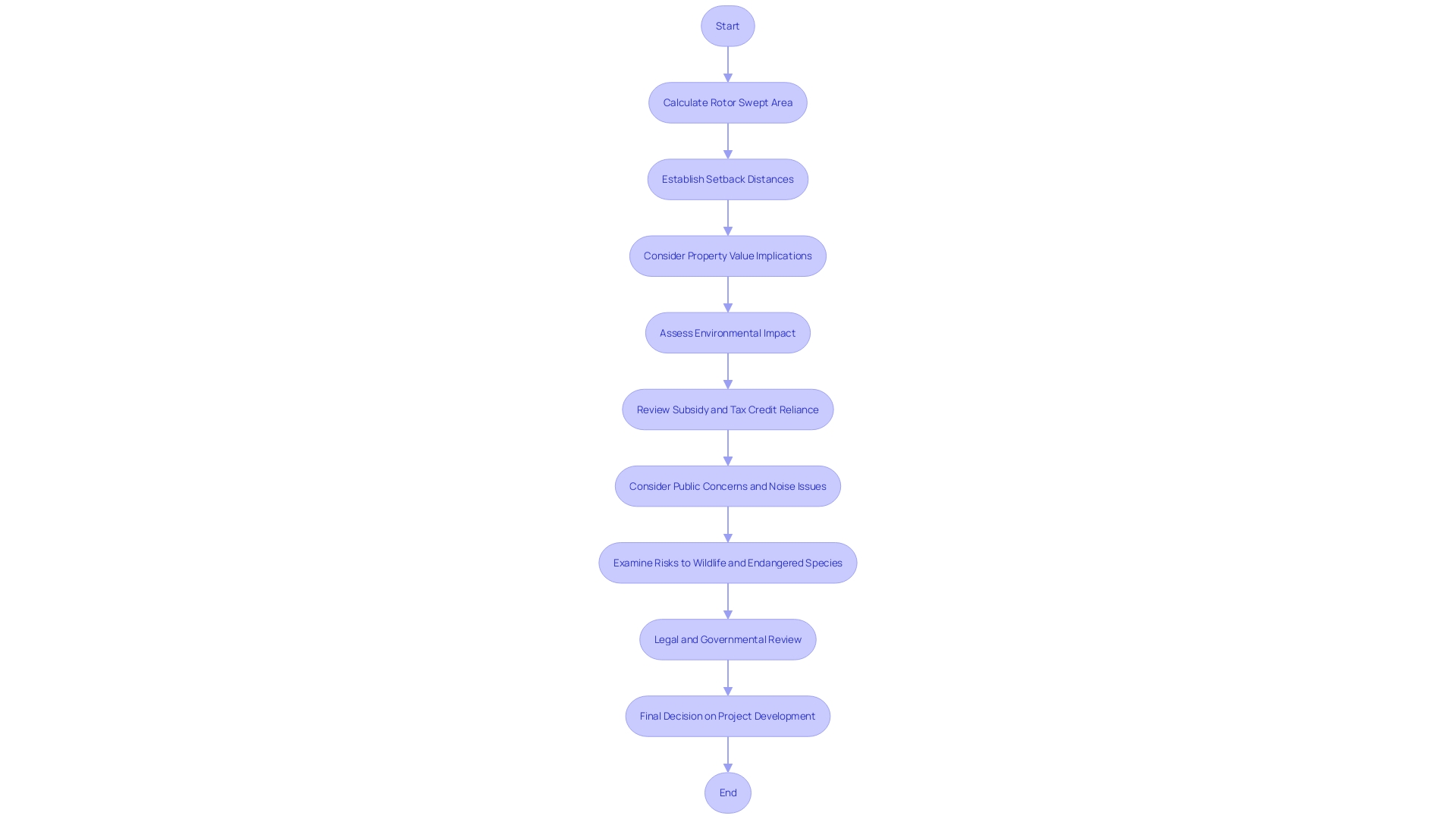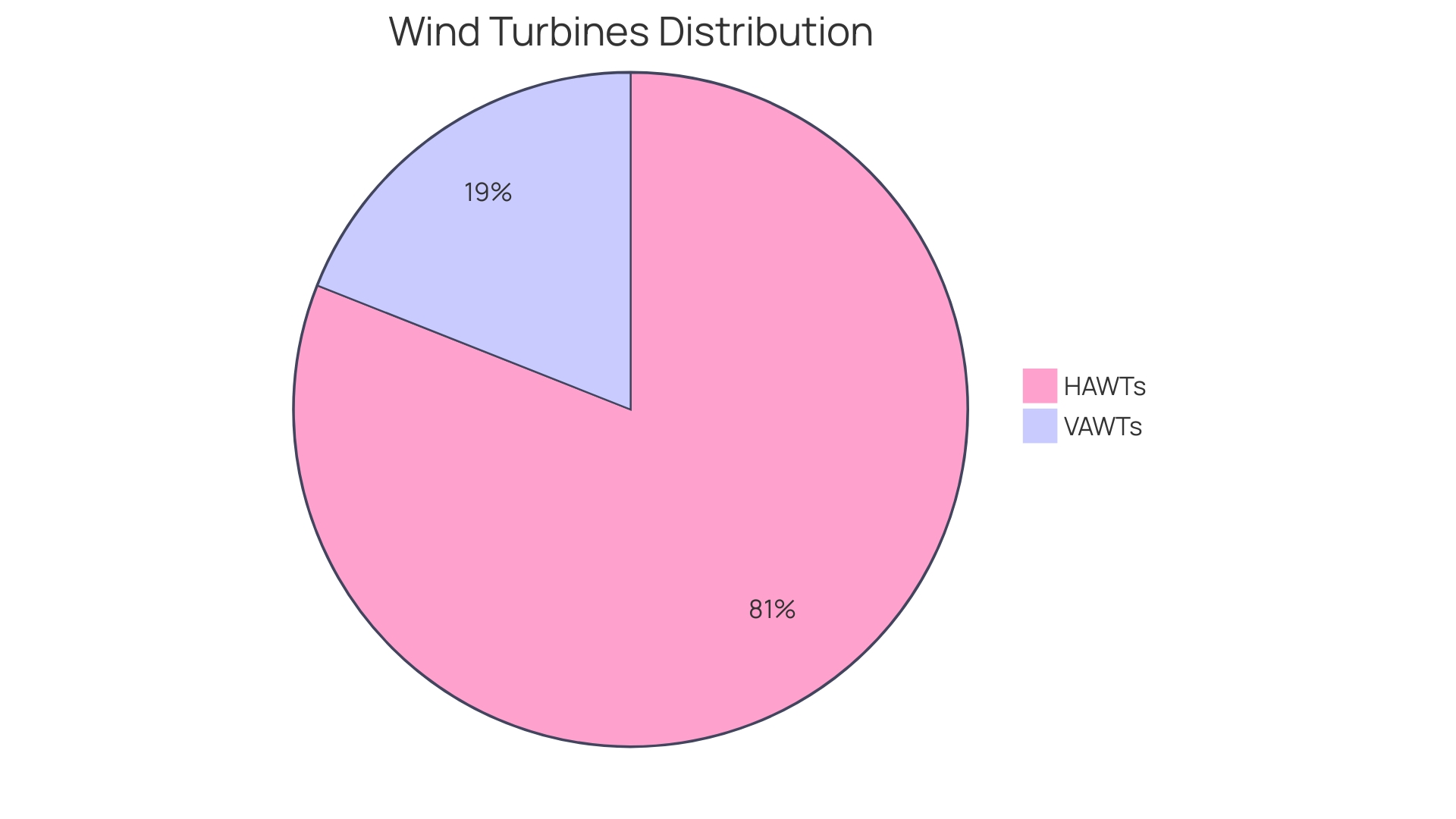Introduction
The spatial planning for wind energy projects involves a careful consideration of various factors that influence land usage. These factors include turbine size, local wind resources, and regional regulatory frameworks. Recent research shows that wind farms have been historically located far from residential properties, but there is now a trend towards proximity to denser populations.
However, concerns about the effects of wind farms on property values, especially in urban areas, still persist. Strategic siting and balancing the benefits of renewable energy with land conservation and property values have become crucial in wind energy projects. This article explores the factors affecting wind turbine land use, standard land use metrics for wind farms, the direct impact area vs. total area in wind farms, turbine spacing and efficiency considerations, average land use per megawatt of wind power, case studies and examples of wind farm land use, the role of vertical axis wind turbines in land use efficiency, and landowner considerations for leasing land for wind farms.
By delving into these topics, this article provides a comprehensive understanding of wind energy projects' complexities and the importance of strategic planning for a sustainable energy future.
Factors Affecting Wind Turbine Land Use
The spatial planning for energy projects is multifaceted, requiring a keen understanding of various factors that influence land usage. The turbine size and capacity, local air resources, and regional regulatory frameworks all play a crucial role in determining the viability and placement of turbines. Recent research shows that farms that generate energy through the movement of air have been historically located at a considerable distance from residential properties, with the average distance decreasing from 148.6 miles in 2005 to 37.1 miles in 2020, indicating a trend towards being closer to more densely populated areas. Despite this shift and public support for renewable power, concerns about wind farms' effects on property values, especially in urbanized areas, persist.
The development of wind power projects has brought to light the significance of strategic siting, particularly in balancing the benefits of renewable energy with the conservation of property values. As cities expand and the demand for clean energy grows, regulatory mechanisms like NEPA have become tools for safeguarding environmental quality, albeit at the cost of extended development timelines and increased expenses.
A recent study in Environmental Science and Technology emphasizes that turbines typically take up only five percent of the area, leaving the majority free for other purposes like farming. This insight is crucial for dispelling misconceptions about wind turbines consuming vast tracts of land, thereby enabling a more harmonious coexistence with existing land uses. The significance of this finding is amplified by the fact that integrating turbines into already-developed areas with existing infrastructure could mitigate land-use conflicts and expedite project approval.
In addition, the International Renewable Energy Agency (IRENA) emphasizes the significance of renewable power generation capacity, which is a fundamental measure in assessing the potential for wind and other renewable sources within a region. The data from the past decade provides an essential snapshot of global trends and capacities, informing policymakers and stakeholders in their decision-making processes.
Considering the intricate terrain of renewable power planning and approval in the United States, a recent report and its accompanying interactive map by the DOE serve as valuable tools for legislators. These resources provide a thorough overview of state-specific siting and permitting procedures, thereby facilitating informed decisions that align with the power needs and environmental goals of various communities.
In the end, the location of wind power initiatives necessitates a careful equilibrium of ecological factors, community concerns, and power generation objectives. By utilizing innovative research, policy tools, and strategic planning, stakeholders can navigate the complexities of acquisition and development in pursuit of a sustainable and resilient future.

Standard Land Use Metrics for Wind Farms
Wind power projects require careful consideration of usage, taking into account both the positioning of turbines and the surrounding environment. The area swept by the rotor blades, known as the rotor swept area, is a critical metric that determines the space the blades will cover as they rotate. Additionally, setback distances are established to maintain a minimum separation between turbines, optimizing airflow and reducing the potential for interference. These factors are essential in calculating the area needed for farms with turbines. Recent studies have shown that although most Americans endorse the expansion of sustainable power, the closeness of turbines to residential areas has ignited discussions regarding their impact on property values. In urban areas, with populations over 250,000, initiatives involving wind energy have been shown to adversely impact property values, contrasting with rural areas where such influence is negligible. Furthermore, as the average distance from a residence to the nearest turbine in the United States has decreased from 148.6 miles in 2005 to 37.1 miles in 2020, the implications for local communities have grown more significant. It is therefore important for developers and communities to comprehend these dynamics completely to make informed decisions about harnessing air currents and its development.

Direct Impact Area vs. Total Area in Wind Farms
When constructing a turbine farm, it's essential to determine the scope of the venture's impact, which encompasses more than just the turbines themselves. The direct impact area encompasses the physical structures—turbines, access roads, and support facilities—while the total area accounts for the necessary buffer zones and setbacks. These additional spaces are designed to mitigate adverse effects on the neighboring land, wildlife, and communities. A thorough comprehension of these spatial needs is crucial for the effective planning and implementation of wind power initiatives.
Moreover, legal frameworks, such as the National Environmental Policy Act (NEPA) in the United States, often require detailed environmental assessments that can introduce significant delays and costs to development. In Europe, efforts like the Wind Power Package from the European Commission, which includes a digital permitting platform, aim to streamline such processes. Notably, the 144-megawatt Lotus Wind Power Project in Viet Nam, financed by the Asian Development Bank, underscores the importance of evaluating the economic and social impacts of renewable power initiatives. This endeavor made a significant contribution to the country's GDP during the construction phase and will persist in offering economic advantages over the next two decades. These instances demonstrate the intricacies and the capability of air power advancements in the wider framework of promoting eco-friendly power investment and speeding up legal authorization for such vital undertakings.
Turbine Spacing and Efficiency Considerations
Maximizing the arrangement of turbines is essential for optimizing electricity generation while minimizing land utilization. Wind turbines must be strategically placed to avoid the wake effect where turbulent air from one turbine reduces the efficiency of others. Studies, such as those by Kumar Reddy G and colleagues, show that precise inter-turbine spacing and orientation are paramount to achieving optimal performance. The influence of such projects goes beyond the power sector. With wind farms now closer than ever to urban areas, research indicates turbines may impact property values in densely populated regions differently than in rural settings. The average distance to the nearest turbine has notably decreased from 148.6 miles in 2005 to just 37.1 miles in 2020, reflecting the rapid expansion of alternative power infrastructure. As the industry grows, balancing the technical requirements of turbine placement with the socioeconomic factors becomes an ever-evolving challenge. Ensuring accessibility for maintenance and adhering to high-quality standards in turbine production are also critical elements. The combined knowledge from research scientists such as Will Gorman and individuals in management roles like Diane Baldwin offers a holistic comprehension of the intricacies associated with renewable energy initiatives, highlighting the significance of strategic preparation and economic evaluation in optimizing land use for the development of sustainable energy.
Average Land Use Per Megawatt of Wind Power
Land usage for wind power initiatives is a fluctuating figure influenced by the interplay of various elements such as local wind resources, turbine technology advancements, and the peculiarities of each site. Usually, a farm that generates power from air movement could take up around 1 to 2 acres per megawatt of installed capacity. This value, however, is not fixed and can change significantly in response to the unique characteristics of each endeavor. Developers are encouraged to conduct thorough studies to determine the exact land requirements for their renewable energy projects.
For example, the Strauss Wind Initiative near Lompoc, California, showcases the careful planning and approval process required to bring a renewable energy undertaking to fruition. The site's location was chosen for its ideal topography, aligning perpendicularly with the prevailing wind currents from the ocean, thereby maximizing energy generation efficiency. This case underlines the importance of considering local geographical features in project planning.
Complicating the development process, regulations such as the National Environmental Policy Act (NEPA) and its state equivalents, like CEQA, can introduce delays ranging from two to six years, along with substantial compliance costs. These legal frameworks, while initially aimed at disclosing environmental impacts, have become tools for opposition groups to impede development, emphasizing the need for thorough legal and regulatory planning.
Solar farms, on the other hand, present a different set of land use metrics. A utility-scale solar power plant typically requires between 5 and 10 acres for each megawatt of generating capacity, as reported by the Solar Energy Industries Association. Unlike wind power, which leverages the vertical space, solar farms spread horizontally, covering more ground.
The recent surge in renewable adoption, particularly solar power, signifies the sector's robust growth. According to the International Energy Agency, solar power is the fastest-growing new source globally, reflecting solar farms' escalating significance in achieving sustainable goals. The revenue from these farms is affected by numerous factors, essential for potential investors to comprehend, as this determines the viability and profitability of solar undertakings.
In conclusion, the land use per megawatt for wind and solar power initiatives is a multifaceted issue, influenced by a range of factors including natural topography and technology, as well as regulatory challenges and community acceptance. It is essential for developers to delve deep into these considerations to effectively plan and execute renewable energy projects.
Case Studies and Examples of Wind Farm Land Use
A recent study encompassing 428 U.S. gust farms and analyzing roughly 500,000 property sales within a five-mile radius has provided new insights into the real-world impact of gust farms on local communities. This study, led by Hoen, has revealed the significance of having comprehensive and precise information to direct communities as they navigate the intricacies of turbine farm development. The study's findings challenge earlier research that suggested little to no significant negative effects on nearby property values. Hoen, with his extensive background in the field, draws upon an ever-growing dataset to offer a nuanced understanding of property value dynamics as more renewable energy projects come online and more data becomes available over time.
The findings from this research are expected to ignite important discussions among communities, illuminating the real consequences of farm development on property values. As more studies like these are conducted and more data becomes available, developers and stakeholders can better comprehend the full scope of farm space requirements for generating wind energy and the potential challenges that may arise. This evolving knowledge base serves as a critical reference for developers to employ best practices and optimize usage strategies while considering the socio economic fabric of the areas they affect.
Vertical Axis Wind Turbines and Land Use Efficiency
In the realm of air power generation, the discussion is moving towards Vertical Axis Wind Turbines (VAWTs) and their role in promoting land use efficiency. VAWTs, with their compact design, enable developers to install multiple units in close proximity without significantly reducing their efficiency. This feature could be a game-changer for farms that harness the power of air currents, especially in areas where space is limited.
Thorough examinations show that VAWTs could transform energy generation, particularly in heavily populated urban areas. Research suggests that turbines constructed in such areas may have a negative impact on residential property values, whereas this isn't a concern in more rural locations. By utilizing VAWTs, developers might mitigate these impacts due to their smaller footprint.
Moreover, the average distance to the nearest turbine from housing in the United States has dramatically decreased from 148.6 miles in 2005 to 37.1 miles in 2020. This proximity underscores the need for turbines like VAWTs that can integrate more seamlessly into local landscapes.
Partnerships between companies like NeXtWind and VSB Group on initiatives such as the Zörbig repowering endeavor showcase the industry's shift towards optimizing land utilization while maintaining high-quality standards. Such partnerships are paving the way for more efficient implementations of air current energy projects.
Furthermore, the sustainability of wind power is highlighted by its low environmental impact, with electricity generation from wind turbines producing no greenhouse gas emissions or air pollutants. VAWTs, specifically, provide extra environmental advantages by necessitating a smaller area, potentially minimizing the demand for deforestation and conserving biodiversity.
The concept of vertical farming, which maximizes land utilization by growing upwards, parallels the principles behind VAWTs, illustrating a broader movement towards sustainable land administration. As the availability of cultivable areas decreases, innovations like VAWTs that require less space become increasingly valuable.
In conclusion, VAWTs present a promising alternative to traditional HAWTs, with potential benefits for urbanized areas and land-scarce regions. By considering the evolving dynamics of terrain usage, power production, and environmental preservation, VAWTs could play a vital role in the future of wind power infrastructure.

Landowner Considerations for Leasing Land for Wind Farms
When considering the lease of property for wind energy projects, landowners are faced with a multifaceted decision-making process. The lease agreement's terms are paramount, as they outline the duration, financial returns, and rights of use during the lease period. Usually, solar leases can last from 20 to 30 years, but negotiations might change this time period. It's important to highlight that these leases may allow for dual usage, such as agricultural activities, which can contribute to an optimized utilization of space.
The financial aspects of leasing for renewable energy initiatives can be substantial, yet they're accompanied by various factors to consider. Hoen's analysis of roughly 500,000 property sales near 428 turbines indicates that proximity to wind farms may initially reduce property values. However, this impact seems to lessen over time, with prices recovering within three to five years post-construction.
Environmental and regulatory compliance is another critical area for landowners to understand. Local, state, and federal regulations govern the progress of sustainable projects, including zoning, land use permits, and environmental assessments. The complexity of these requirements underscores the advantage of partnering with experienced solar companies to navigate the legal landscape.
Recent studies shed light on the nuanced impacts of wind farms, offering fresh perspectives on property values and community implications without using the word 'wind'. As wind power installations become more prevalent, especially in urbanized regions, these insights are increasingly relevant. The shift towards renewable energy sources is a collective journey, with individual landowners playing a crucial role in facilitating this transition.
Conclusion
In conclusion, wind energy projects require careful planning and consideration of factors such as turbine size, local wind resources, and regulatory frameworks. While there is a trend towards locating wind farms closer to populated areas, concerns about their impact on property values persist, especially in urban regions.
Strategic siting and balancing the benefits of renewable energy with land conservation and property values are crucial. Recent research shows that wind farms occupy a small percentage of land, leaving the majority available for other uses like agriculture.
Optimizing the layout and spacing of wind turbines is essential for maximizing energy production and minimizing land use. Precise inter-turbine spacing and orientation are crucial for optimal performance and to avoid interference.
Case studies and research provide valuable insights into the real-world impact of wind farms on property values and communities. Understanding these findings helps developers better comprehend wind farm land requirements and potential challenges.
Vertical Axis Wind Turbines (VAWTs) offer a promising alternative to traditional turbines, particularly in urban areas. Their compact design allows for multiple units to be installed in close proximity, potentially reducing negative impacts on property values.
For landowners considering leasing their land for wind projects, evaluating lease agreement terms and understanding environmental and regulatory compliance are important. While proximity to turbines may initially affect property values, studies suggest that prices tend to recover within a few years post-construction.
In conclusion, wind energy projects require comprehensive planning and consideration of various factors to achieve a sustainable energy future. By leveraging research, strategic planning, and understanding the complexities involved, stakeholders can navigate the challenges and balance environmental considerations, community interests, and energy generation goals.




